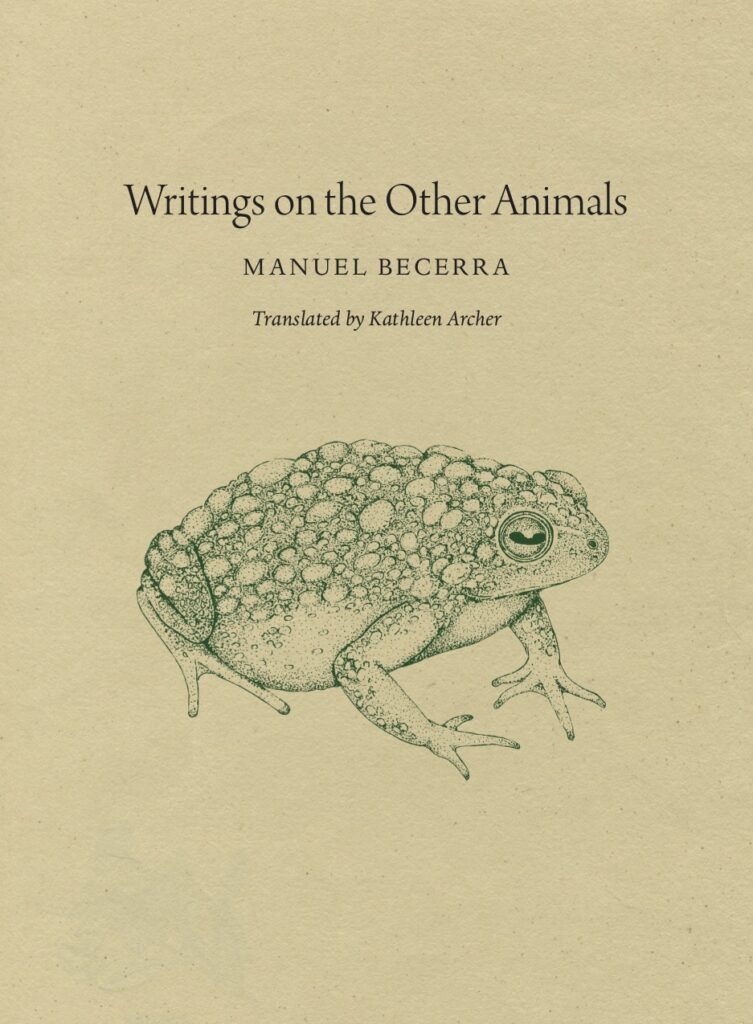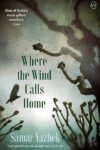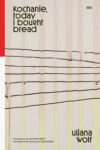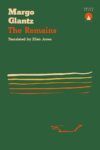
[The Song Bridge Project; 2022]
Translated from the Spanish by Kathleen Archer
It isn’t intuitive to love the toad. Managing to fuse the grotesque with the uninspiring, it lacks the litheness and allure of its cousin the frog, instead sporting a smoker’s croak and a body constellated with warts. That the fairytale prince is transfigured into a frog, not a toad, is fitting, since the latter feels incapable of harboring royalty. Toads instead serve as vessels for witches and retain a similar status as outcasts. An affront to decorum for how they look and how they live (hideous enough, in both cases, to amount to transgression), they live on society’s fringes, haunting the woods and bogs.
While there are no witches in Manuel Becerra’s poetry collection Writings on the Other Animals, the specter of monstrosity, accompanied by a distant cackle (Another’s voice? Or the echo of your own?), pervades the pages. The collection, translated from the Spanish by Kathleen Archer, articulates—and, at times, exalts—the bestial in the human, and the transcendent in the animal. The book’s title encapsulates this aim, the modifier “other” identifying human beings as simply one animal among many.
The toad—whose image graces the book’s cover—appears in the third section of Writings, “(Theory of the Toad).” This lettered series, switching between prose and staggered lines, takes the toad’s ugliness (physical and otherwise) as a subject for lyric speculation—a self-aware turning of nature’s beauty on its head. The toad is “the opposite of a swan,” “the antipode of the / butterfly,” and “a strange illness in the foliage, a swelling in the trees.” Its ugliness is remarkable, sublime, even—it is “the only amphibian to develop, in the light of the day, the level of ugliness which the fish of the abyss needed the abyss to attain.” If we can only know beauty by what it’s defined against, then the aberrance of the toad is no less essential to beauty than the beautiful thing itself. This is what brings Becerra to sing the toad’s praises.
Yet there’s a second-order game here: that of how seriously Becerra takes his own argument. His tone is awe-adjacent yet cheeky, half-nihilist, pastoral reverie in a fisheye lens. It drifts toward irony without definitively landing. “(g)” ends with the line, “There is no constellation of the toad,” droll and deadpan, while “(h)” playfully riffs on Blake’s “The Tyger,” asking the toad, “what magnificent hand put thee where light flees and every rose turns its back once thou cross the meadow?” One wonders whether Becerra’s true aim is to give the toad its overdue poetic consideration, or to introduce an element of gleeful chaos into the taxonomy of beauty. It’s indeterminate, but that just might be the point.
Compelling, too, are Becerra’s meditations on time and transformation. Death’s inevitability looms over the collection, which is preoccupied with non-human modes of coming to know life as limited. “Unlike animals,” Becerra writes, “people don’t know how to die. When their time comes, animals sink, dig down, until, deep inside themselves, they find the stone of death.” A stone can be precious, like a gem, or destructive, like a falling rock. An animal’s immanent knowledge of death may be similarly double-edged, but it certainly beats our all too human floundering and denial.
In “Seasick Letter,” the speaker, suffering from the titular malady, yearns for a life not bound by the strictures of linear time. Looking seaward for solace, he fixes his gaze on the tide. Though “simple and certain” in its daily recurrence, it nevertheless contains a great and unsettling power—it “works with the abyss, like you, / disturbs with each of its planks / the firmness you use to grip the pen.” In his vision of the seaside, the speaker intuits a life beyond the meaningless repetition of “writ[ing] and stack[ing] papers.” Like the tide, he would “[s]top the scripture for a moment // and write the immortal in the sand.” Here, “the immortal” is, paradoxically, ephemeral—words written in sand are washed away by the waves, while the “writing” of the tide itself, the repeated action of wind and water to shape the coastline, holds change as its only constant. Yet for Becerra, uptake into this flux entails its own sort of immortality by virtue of incorporation into a greater whole. The speaker yearns to be part of this cyclical, persistent motion—the exact quality that scripture (or the lyric poem, for that matter) sacrifices when it seeks to pin a moment eternally in place. The book’s layout heightens this sense of the nunc stans. The paperback edition of Writings is top-bound and oriented vertically, tweaking the act of reading; our eyes don’t jump laterally, but descend, page after page, along a single axis. The book’s hardcover edition pushes the idea of a gapless reading experience further, printing the poems on a single sheet of folded paper, a design reminiscent of Anne Carson’s Nox and Octavio Paz’s Blanco.
Somewhat more mixed are the results of Becerra’s attempts to illuminate what’s animal in the human. Sex, most notably, tends to slip into familiar tropes. An encounter with “French Julissa” culminates with the speaker “[unhinging his] jaw like a snake to devour, between her legs, the flower of extermination”; French Julissa, prey to the speaker’s predator, seems to exist as little more than an object to be consumed. During such moments in Writings, one senses a schema at work: the human (interpreter of the world, guided by reason) and the animal (substance of the world, guided by instinct) set against one another, then smashed deviously together, like a child making a doll and plastic dinosaur kiss. Though Becerra aims to rough up the edges of this schema, he runs the risk of reifying it: To blur a boundary presumes the existence of that boundary in the first place. When, in “Bob Discovers Himself in the Mirror,” a persona poem from the perspective of performance artist Bob Flanagan, Becerra writes “I’m naked, as close to a savage as I can be,” the moment feels less like a limit case than an episode of the carnivalesque. Despite the momentary inversion, the two dyads, human and animal, civilized and savage, still map frictionlessly onto each other.
Fortunately, this conceptual muddiness is countered by Becerra’s skill as a poet. On the level of the line, he regularly achieves a kind of sublime deviance from beauty. Archer’s translation, dexterous and vivid, renders Becerra’s poems in language that conjures the sense of strangeness they portray. Phrases like “an irreversible God” and “millimetric patience” demand a strange reconciliation of noun with modifier, while images like “the polyhedron that destroys horses,” or an eel with a face “somewhere between a snake and a seasonal fern,” endow Becerra’s language itself with the very uncanny beauty—or beautiful uncanniness—he finds in the toad.
These poems’ jaunts into the ironic and surreal, do not, at final tally, render Becerra’s work unserious. Grief, fear, and regret, however refracted, are never wholly absent from Writings, and by the collection’s final pages, where the subject shifts from animal to human life, we can feel their accumulated weight. The closing “[Poem about Attributions],” which, title notwithstanding, is entirely in italics, recounts childhood memories with a nostalgia seeded with menace. The poem opens conspiratorially: “let’s blame the children from the villa / on Santiago Street — the children we once were — for the rocks / and the death of all those birds.” Having succeeded in diverting the blame, the poem moves through other memories of pains and transgressions—a father’s death, boys beaten up for kissing—only to return to rocks in its final lines:
[. . .] you thought you saw
an angel up the in the lemon trees
and tell about how out of fear you attacked it with rocks
and if you decide one day
to put it on paper do it in cursive
and say it wasn’t you
Italics isn’t cursive, nor is an intention to lie the lie itself. But a shift has unmistakably taken place, from blaming “the children we once were” for the death of the birds to admitting that the rocks came from one’s own hand. By the poem’s end, the speaker has produced something like an accounting of wrongs, including not only the acts he committed but those he didn’t stop. Here, a sense of moral obligation, latent throughout the book, achieves its full expression. For Becerra, to acknowledge that one has caused harm amounts to a precondition for living ethically—among the other animals, and those one calls one’s own.
Peter Myers (@trillycollins) is a poet living in New York. Recent work has appeared in Fence, Qui Parle, jubilat, No Materialism, Hot Pink Mag, and elsewhere.
This post may contain affiliate links.







